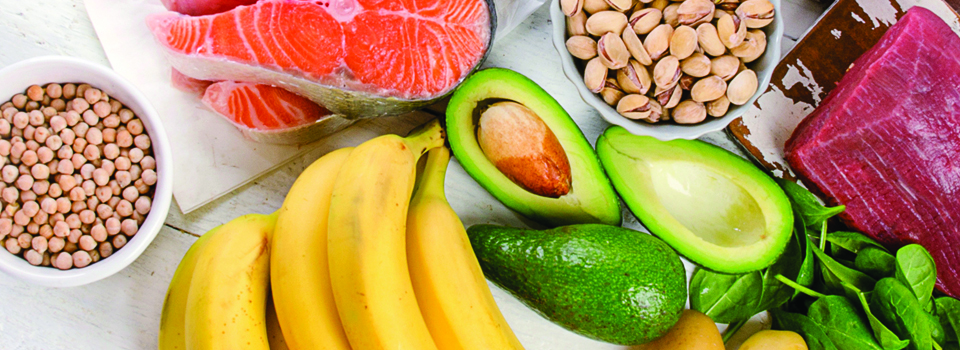
The Relationship Between B Vitamins & Energy Production
By Caitlin Beale, MS, RDN+
The B vitamins are a large group of water-soluble vitamins. These nutrients play many roles in your health, from brain function to red blood cell production. 1 But one of their most important jobs is to support energy production in your cells. 2
The eight B-vitamins include:
✓ B1 (thiamin)
✓ B2 (riboflavin)
✓ B3 (niacin)
✓ B5 (pantothenic acid)
✓ B6 (pyridoxine)
✓ B7 (biotin)
✓ B9 (folate)
✓ B12 (cobalamin)
While each has an individual role in energy production, they all work together to keep things working optimally. In this article, we will share the details on how these vitamins help power all the functions in your body.
How is Energy Made in Your Body?
To understand how the B vitamins support energy production, it’s helpful to understand the process of energy production in the body. When you eat food, it’s broken down into smaller molecules during digestion so they can be absorbed. The smaller subunits from carbohydrates, fat, and protein are used to make or store energy in your cells.
Carbohydrates are your body’s preferred fuel because they are easily turned into energy. Still, the body can use protein and fat for energy if carbohydrates are scarce in your diet (as seen in ketogenic diets).
Carbohydrates are broken down to sugar, or glucose, which enters your bloodstream and can be taken up by cells for immediate energy or stored for later. 3
But we don’t just store nutrients. Instead, they are turned into a specialized energy storage molecule called adenosine triphosphate (ATP).
Energy from your food goes through a series of complex metabolic pathways where it’s converted into ATP inside your cell. ATP is what powers cellular processes like breathing, thinking, and moving.
Where do B vitamins come in? Without B vitamins, the chemical reactions to make or use ATP can’t occur. 4
How do B Vitamins Help with Energy Production?
The conversion of food into energy requires a series of enzymatic reactions. Enzymes are proteins that act as catalysts for processes in your body. The B vitamins act as coenzymes or enzyme helper molecules to support your metabolic processes. They are needed for the energy-producing enzymes to do their job. 1
In other words, B vitamins help your body convert food into energy, and they are needed for enzymes that store or release energy in your body to work correctly.
Some examples of the role of B vitamins include:
• Thiamine, vitamin B1, helps the body use glucose as energy by supporting ATP synthesis. 5
• Niacin, vitamin B3, is involved in ATP synthesis and the metabolism of carbohydrates, fats, and proteins. 6
• Pyridoxine, or vitamin B6,is needed for amino-acid synthesis. It also helps release stored glucose from the liver and muscles in a process called glycogenolysis. 7 Pyridoxal phosphate is the active form of vitamin B6 and is a coenzyme for synthesis of amino acids, neurotransmitters (serotonin, norepinephrine), sphingolipids, aminolevulinic acid. 8
• Cobalamin or vitamin B12 is needed for fat and protein breakdown, energy metabolism, and red blood cell production. 9
B Vitamins, Red Blood Cells, and Energy
The relationship with red blood cells is another way that the B vitamins can impact your energy levels. Vitamin B12 and folate work with iron to make new red blood cells in your body. 10
Red blood cells have a lifespan of around 120 days. 11 Your red blood cells are closely linked with energy because they carry oxygen throughout your body. Without enough vitamin B12 or folate, the body can’t make healthy new cells. Instead, the cells don’t develop normally. This can lead to fatigue and weakness because fewer red blood cells mean less oxygen delivered to your cells. 9

Do B Vitamin Supplements Support Healthy Energy Levels?
Because the B vitamins are so deeply involved in energy metabolism, it may seem like adding more to your daily intake could give you a never-ending supply of energy production. But B vitamins are water-soluble, so your body doesn’t store more than it needs. More isn’t necessarily better.
That said, suboptimal status could impact metabolic and cellular functions in the body, which impairs energy production and many other functions in the body. In this case, supplementation can support healthy energy metabolism.
B vitamins are found in many different foods. A well-balanced, diverse diet should provide enough for a healthy individual, but there are situations when you may consider supplementation:
• Advanced age. Older adults may need to consider vitamin B12 supplementation even if they eat a nutrient-rich diet. Vitamin B12 needs healthy stomach acid and carrier proteins to release it into an absorbable form from the food you eat. But age can influence how much we make.
It’s been estimated that even healthy adults only absorb about half of the vitamin B12 they ingest. 12 As a result, vitamin B12 absorption can be impacted, so additional supplements could be helpful on top of a nutrient-rich diet. 13
• Pregnancy. Nutrients needs increase overall during pregnancy, including the B vitamins. For example, folate is essential for supporting the growth and development of the baby’s spine, and vitamin B12 is critical for brain development. 14
• Gastrointestinal conditions. Any condition that impacts the health of the stomach or intestine can interfere with the normal absorption of vitamins and minerals. 15 People with gut inflammation can have difficulty digesting food to be properly absorbed.16 Or they simply do not feel well enough to eat a well-balanced diet and miss out on these important nutrients.
• Genetic alterations. Your genes can impact how your body uses a nutrient or a vitamin. Certain genetic alterations called single nucleotide polymorphisms (SNPs) could interrupt the conversion from an inactive to an active form of a vitamin. 17 This means that even if you get enough in the diet, your body can’t use it if it’s not in an active form. In this case, supplementing with the active form can help.
• Specialized diets. If your diet is low in specific foods, it could put you at a higher risk for suboptimal intake. For example, since vitamin B12 is found in animal-based foods, people who follow a vegan diet should supplement with B12 or seek fortified foods.
Also, since grains are a good source of many B vitamins, people who follow very low-carb diets without carbohydrates may need to supplement with B vitamins to meet needs. Even diets that are very low calorie could warrant supplementation simply because they don’t provide enough food to the recommended amount. Interestingly, one review found that healthy young women with physically active lifestyles who diet or have nutrient-poor eating habits were at risk for inadequate intake of B vitamins. 19
• Heavy alcohol intake. Heavy alcohol consumption puts you at risk for several nutrient deficiencies, especially the B vitamins. One reason is that drinking can take the place of food for some people. Misusing alcohol can also lead to poor absorption of thiamine and negatively affect the way your cells use thiamine. 20

B Vitamins and Energy Go Hand-in-Hand
B vitamins are a vital piece of energy production and metabolism. Their job is to support the enzymes that help you process the food you eat into energy units your body can use.
You can find the B vitamins in many foods, but different needs may warrant a complex that includes many B vitamins or a single vitamin option. Your health care practitioner can help you decide if supplementation is a good idea for you.
.
.
.
Caitlin Beale, MS, RDN is a registered dietitian and freelance health writer. She has a master’s degree in nutrition and over ten years of experience as a registered dietitian. You can learn more about Caitlin Beale, MS, RDN at www.caitlinbealewellness.com.
+The views expressed in this article are those of the authors. They do not reflect the opinions or views of Pure Encapsulations®.
1Kennedy, David O. “B Vitamins and the Brain: Mechanisms, Dose and Efficacy—A Review.” Nutrients8, no. 2 (January 28, 2016): 68. https://doi.org/10.3390/nu8020068.
2Depeint, Flore, W. Robert Bruce, Nandita Shangari, Rhea Mehta, and Peter J. O’Brien. “Mitochondrial Function and Toxicity: Role of the B Vitamin Family on Mitochondrial Energy Metabolism.” Chemico-Biological Interactions163, no. 1–2 (October 27, 2006): 94–112. https://doi.org/10.1016/j.cbi.2006.04.014.
3Alberts, Bruce, Alexander Johnson, Julian Lewis, Martin Raff, Keith Roberts, and Peter Walter. “How Cells Obtain Energy from Food.” Molecular Biology of the Cell. 4th Edition, 2002. https://www.ncbi.nlm.nih.gov/books/NBK26882/.
4“Human Metabolism, Energy, Nutrients | Learn Science at Scitable.” Accessed November 15, 2021. https://www.nature.com/scitable/topicpage/nutrient-utilization-in-humans-metabolism-pathways-14234029/.
5Lonsdale, Derrick. “A Review of the Biochemistry, Metabolism and Clinical Benefits of Thiamin(e) and Its Derivatives.” Evidence-Based Complementary and Alternative Medicine3, no. 1 (March 2006): 49–59. https://doi.org/10.1093/ecam/nek009.
6Meyer-Ficca, Mirella, and James B Kirkland. “Niacin12.” Advances in Nutrition7, no. 3 (May 9, 2016): 556–58. https://doi.org/10.3945/an.115.011239.
7Parra, Marcelina, Seth Stahl, and Hanjo Hellmann. “Vitamin B6 and Its Role in Cell Metabolism and Physiology.” Cells7, no. 7 (July 22, 2018): 84. https://doi.org/10.3390/cells7070084.
8National Center for Biotechnology Information (2021). PubChem Compound Summary for CID 1051, Pyridoxal phosphate. Retrieved December 6, 2021 from https://pubchem.ncbi.nlm.nih.gov/compound/Pyridoxal-phosphate.
9Kräutler, Bernhard. “Biochemistry of B12-Cofactors in Human Metabolism.” Sub-Cellular Biochemistry56 (2012): 323–46. https://doi.org/10.1007/978-94-007-2199-9_17.
10Koury, Mark J., and Prem Ponka. “New Insights into Erythropoiesis: The Roles of Folate, Vitamin B12, and Iron.” Annual Review of Nutrition24 (2004): 105–31. https://doi.org/10.1146/annurev.nutr.24.012003.132306.
11“Regulation of Red Cell Life-Span, Erythropoiesis, Senescence and Clearance | Frontiers Research Topic.” Accessed November 19, 2021. https://www.frontiersin.org/research-topics/1656/regulation-of-red-cell-life-span-erythropoiesis-senescence-and-clearance.
12Hoey, Leane, J. J. Strain, and Helene McNulty. “Studies of Biomarker Responses to Intervention with Vitamin B-12: A Systematic Review of Randomized Controlled Trials.” The American Journal of Clinical Nutrition89, no. 6 (June 2009): 1981S-1996S. https://doi.org/10.3945/ajcn.2009.27230C.
13Stover, Patrick J. “Vitamin B12 and Older Adults.” Current Opinion in Clinical Nutrition and Metabolic Care13, no. 1 (January 2010): 24–27. https://doi.org/10.1097/MCO.0b013e328333d157.
14Finkelstein, Julia L, Alexander J Layden, and Patrick J Stover. “Vitamin B-12 and Perinatal Health123.” Advances in Nutrition6, no. 5 (September 5,2015): 552–63. https://doi.org/10.3945/an.115.008201.
15Wierdsma, Nicolette J., Marian A. E. van Bokhorst-de van der Schueren, Marijke Berkenpas, Chris J. J. Mulder, and Ad A. van Bodegraven. Nutrients5, no. 10 (September 30, 2013): 3975–92. https://doi.org/10.3390/nu5103975.
16Ward, Mark G., Viraj C. Kariyawasam, Sathis B. Mogan, Kamal V. Patel, Maria Pantelidou, Agata Sobczyńska-Malefora, François Porté, et al. Inflammatory Bowel Diseases21, no. 12 (December 2015): 2839–47. https://doi.org/10.1097/MIB.0000000000000559.
17Zinck, John WR, Margaret de Groh, and Amanda J MacFarlane. “GeneticModifiers of Folate, Vitamin B-12, and Homocysteine Status in a Cross-Sectional Study of the Canadian Population.” The American Journal of Clinical Nutrition101, no. 6 (June 1, 2015): 1295–1304. https://doi.org/10.3945/ajcn.115.107219.
18Gilsing, A. M. J., F. L. Crowe, Z. Lloyd-Wright, T. a. B. Sanders, P. N. Appleby, N. E. Allen, and T. J. Key. “Serum Concentrations of Vitamin B12 and Folate in British Male Omnivores, Vegetarians and Vegans: Results from a Cross-Sectional Analysis of theEPIC-Oxford Cohort Study.” European Journal of Clinical Nutrition64, no. 9 (September 2010): 933–39. https://doi.org/10.1038/ejcn.2010.142.
19Huskisson, E., S. Maggini, and M. Ruf. “The Role of Vitamins and Minerals in Energy Metabolism and Well-Being.” The Journal of International Medical Research35, no. 3 (June 2007): 277–89. https://doi.org/10.1177/147323000703500301.
20Martin, Peter R., Charles K. Singleton, and Susanne Hiller-Sturmhöfel. Alcohol Research & Health: The Journal of the National Institute on Alcohol Abuse and Alcoholism27, no. 2 (2003): 134–42.


 Facebook
Facebook Instagram
Instagram